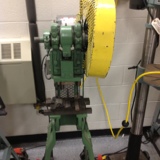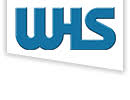Information
-
Document No.
-
Audit Title
-
Client / Site
-
Conducted on
-
Prepared by
-
Location
General Assessment
-
What company manufactured this power press?
-
What is the serial number?
-
Is this press equipped with a full or partial revolution clutch?
-
Is the press fed by hand?
-
Do hands enter the die area?
-
Can not use die enclosure, restraints.
-
What is the maximum time for die enclosure?
-
Can the press be hand actuated?
-
Can the press be foot actuated?
-
How many operators are to use the press during each shift?
-
Is the start/stop switch protected from accidental activation?
-
What can be done or installed to protect the start/stop switch?
-
Does the start/stop switch have a disconnect option?
-
Should a disconnect option be installed? Why or why not?
Point of Operation
-
Please take a picture of the point of operation safeguard.
-
The point of operation is equipped with what kind of safeguarding?
-
What kind of safeguarding should be utilized? Be sure to choose the best safeguarding system based upon the process and press clutch.
-
What kind of device?
-
Advantages:
-Simplicity of controls
Disadvantages:
-Other guards are also required for operator protection--usually fixed barrier guards
-Requires frequent maintenance
-May not be adaptable to stock variation
The two hand trips/controls must be a safe distance from the point of operation according to the stopping time of the press. -
Advantages:
-Little risk of mechanical failure
Disadvantages:
-limits movement of the operator
-May obstruct work-space
-Adjustments must be made for specific operations and each individual
-Requires close supervision of the operator's use of the equipment -
Advantages:
-Eliminates the need for auxiliary barriers or other interference at the danger zone
Limitations:
-May limit movement of operator
-May obstruct work-space around operator
-Adjustments must be made for specific operations and for each individual
-Requires frequent inspections and regular maintenance
-Requires close supervision of the operator's use of the equipment -
Advantages:
-Can allow freer movement for operator; simplicity of use; no adjustments required
Disadvantages:
-Does not protect against mechanical failure
-May require frequent alignment and calibration
-Excessive vibration may cause lamp filament damage and premature burnout
-Limited to machines that can be stopped -
What kind of guard?
-
Advantages:
-Off-the-shelf guards are often commercially available
Disadvantages:
-Protection may not be complete at all times
-May require frequent maintenance and/or adjustment
-May interfere with visibility -
Advantages:
-Can be constructed to suit many specific applications
-Can be adjusted to admit varying sizes of stock
Disadvantages:
-Hands may enter danger area
-Protection may not be complete at all times
-May require frequent maintenance and/or adjustment
-The guard can be defeated by the operator
-May interfere with visibility -
Advantages:
-Can provide maximum protection
-Allows access to machine for removing jams without time-consuming removal of fixed guards
Limitations:
-Requires careful adjustment and maintenance
-May be easy to disengage -
Advantages:
-Can be constructed to suit many applications
-In-plant construction is often possible
-Can provide maximum protection
-Usually requires minimum maintenance
-Can be suitable for high production and high repetition operations
Disadvantages:
-May interfere with visibility
-Can be limited to specific operations
-Machine adjustments and repair often require guard removal, thereby necessitating other means of protection for maintenance personnel -
What kind of device is it?
-
Advantages:
-Simplicity of controls
Disadvantages:
-Other guards are also required for operator protection--usually fixed barrier guards
-Requires frequent maintenance
-May not be adaptable to stock variation
The two hand trips/controls must be a safe distance from the point of operation according to the stopping time of the press. -
Advantages:
-Little risk of mechanical failure
Disadvantages:
-limits movement of the operator
-May obstruct work-space
-Adjustments must be made for specific operations and each individual
-Requires close supervision of the operator's use of the equipment -
Advantages:
-Eliminates the need for auxiliary barriers or other interference at the danger zone
Limitations:
-May limit movement of operator
-May obstruct work-space around operator
-Adjustments must be made for specific operations and for each individual
-Requires frequent inspections and regular maintenance
-Requires close supervision of the operator's use of the equipment -
Advantages:
-Can allow freer movement for operator; simplicity of use; no adjustments required
Disadvantages:
-Does not protect against mechanical failure
-May require frequent alignment and calibration
-Excessive vibration may cause lamp filament damage and premature burnout
-Limited to machines that can be stopped -
What kind of guard?
-
Advantages:
-Off-the-shelf guards are often commercially available
Disadvantages:
-Protection may not be complete at all times
-May require frequent maintenance and/or adjustment
-May interfere with visibility -
Advantages:
-Can be constructed to suit many specific applications
-Can be adjusted to admit varying sizes of stock
Disadvantages:
-Hands may enter danger area
-Protection may not be complete at all times
-May require frequent maintenance and/or adjustment
-The guard can be defeated by the operator
-May interfere with visibility -
Advantages:
-Can provide maximum protection
-Allows access to machine for removing jams without time-consuming removal of fixed guards
Limitations:
-Requires careful adjustment and maintenance
-May be easy to disengage -
Advantages:
-Can be constructed to suit many applications
-In-plant construction is often possible
-Can provide maximum protection
-Usually requires minimum maintenance
-Can be suitable for high production and high repetition operations
Disadvantages:
-May interfere with visibility
-Can be limited to specific operations
-Machine adjustments and repair often require guard removal, thereby necessitating other means of protection for maintenance personnel
Power Transmission
-
Please take a picture of the power transmission safeguard.
-
The power transmission is equipped with what kind of safeguarding?
-
What kind of safeguarding should be utilized?
-
What kind of device is it?
-
Advantages:
-Simplicity of controls
Disadvantages:
-Other guards are also required for operator protection--usually fixed barrier guards
-Requires frequent maintenance
-May not be adaptable to stock variation
The two hand trips/controls must be a safe distance from the point of operation according to the stopping time of the press. -
Advantages:
-Little risk of mechanical failure
Disadvantages:
-limits movement of the operator
-May obstruct work-space
-Adjustments must be made for specific operations and each individual
-Requires close supervision of the operator's use of the equipment -
Advantages:
-Eliminates the need for auxiliary barriers or other interference at the danger zone
Limitations:
-May limit movement of operator
-May obstruct work-space around operator
-Adjustments must be made for specific operations and for each individual
-Requires frequent inspections and regular maintenance
-Requires close supervision of the operator's use of the equipment -
Advantages:
-Can allow freer movement for operator; simplicity of use; no adjustments required
Disadvantages:
-Does not protect against mechanical failure
-May require frequent alignment and calibration
-Excessive vibration may cause lamp filament damage and premature burnout
-Limited to machines that can be stopped -
What kind of guard?
-
Advantages:
-Off-the-shelf guards are often commercially available
Disadvantages:
-Protection may not be complete at all times
-May require frequent maintenance and/or adjustment
-May interfere with visibility -
Advantages:
-Can be constructed to suit many specific applications
-Can be adjusted to admit varying sizes of stock
Disadvantages:
-Hands may enter danger area
-Protection may not be complete at all times
-May require frequent maintenance and/or adjustment
-The guard can be defeated by the operator
-May interfere with visibility -
Advantages:
-Can provide maximum protection
-Allows access to machine for removing jams without time-consuming removal of fixed guards
Limitations:
-Requires careful adjustment and maintenance
-May be easy to disengage -
Advantages:
-Can be constructed to suit many applications
-In-plant construction is often possible
-Can provide maximum protection
-Usually requires minimum maintenance
-Can be suitable for high production and high repetition operations
Disadvantages:
-May interfere with visibility
-Can be limited to specific operations
-Machine adjustments and repair often require guard removal, thereby necessitating other means of protection for maintenance personnel -
If a safeguard is present, is it securely attached to the machine?
-
What needs to be done in order for the safeguard to be more securely attached?
-
If a safeguard is present; is it possible to reach in, through, or around the safeguard (maximum opening 1/2")?
-
What needs to be done to prevent reaching in, through, or around the safeguard?
-
Is the power transmission still able to be accessed for regular maintenance?
Actuating Devices
-
Please take a picture of the hand actuating device.
-
Is the hand actuating device protected against accidental actuation?
-
What should be done or installed to prevent accidental operation?
-
Please take a picture of the foot actuating device.
-
Is the foot actuating device protected against accidental actuation?
-
What should be done or installed to prevent accidental operation?
-
Is the foot treadle covered on at least three sides?
-
Does the pedal have a nonslip contact area?
-
Does the foot actuator have a functional spring return?
-
Upon completion of this audit, all members of your group must type then sign your name in the space.











